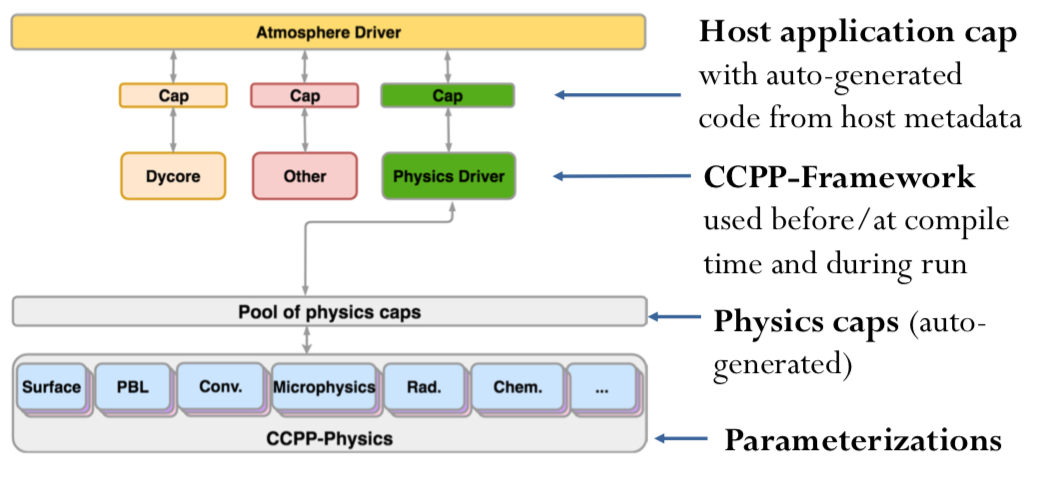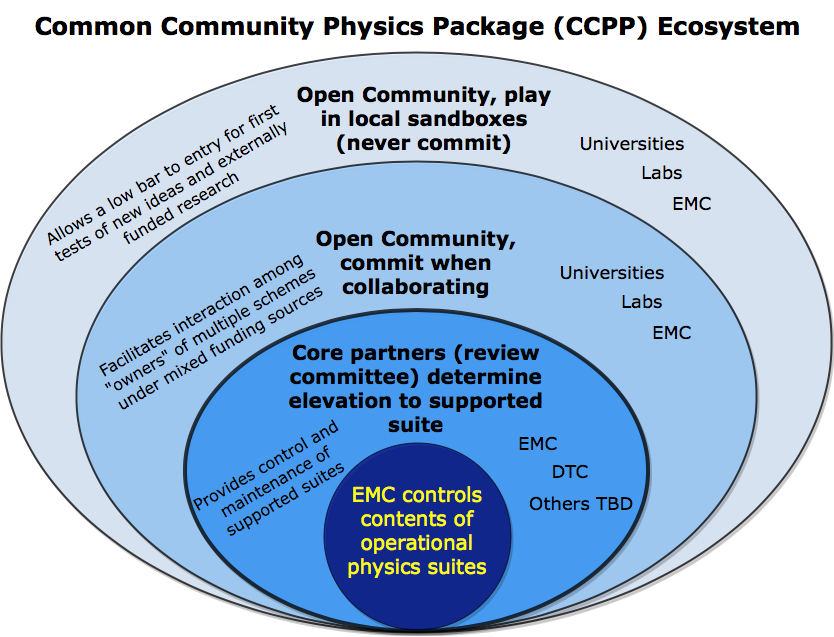1. CCPP Overview¶
Warning
The information in this document is up to date with the CCPP and GMTB SCM v3 public release as of June 17, 2019. If you are a developer looking for more current information, please obtain and build the up-to-date Technical Documentation from the master branch of the ccpp-framework code repository:
git clone https://github.com/NCAR/ccpp-framework cd ccpp-framework/doc/CCPPtechnical make html make latexpdf
Ideas for this project originated within the Earth System Prediction Capability (ESPC) physics interoperability group, which has representatives from the US National Center for Atmospheric Research (NCAR), the Navy, National Oceanic and Atmospheric Administration (NOAA) Research Laboratories, NOAA National Weather Service, and other groups. Physics interoperability, or the ability to run a given physics suite in various host models, has been a goal of this multi-agency group for several years. An initial mechanism to run the physics of NOAA’s Global Forecast System (GFS) model in other host models was developed by the NOAA Environmental Modeling Center (EMC) and later augmented by the NOAA Geophysical Fluid Dynamics Laboratory (GFDL). The CCPP expanded on that work by meeting additional requirements put forth by NOAA, and brought new functionalities to the physics-dynamics interface. Those include the ability to choose the order of parameterizations, to subcycle individual parameterizations by running them more frequently than other parameterizations, and to group arbitrary sets of parameterizations allowing other computations in between them (e.g., dynamics and coupling computations).
The architecture of the CCPP and its connection to a host model is shown in Figure 1.1. There are two distinct parts to the CCPP: a library of physical parameterizations (CCPP-Physics) that conforms to selected standards and an infrastructure (CCPP-Framework) that enables connecting the physics to a host model.

Fig. 1.1 Architecture of the CCPP and its connection to a host model, represented here as the driver for an atmospheric model (yellow box). The dynamical core (dycore), physics, and other aspects of the model (such as coupling) are connected to the driving host through the pool of physics caps. The CCPP-Physics is denoted by the gray box at the bottom of the physics, and encompasses the parameterizations, which are accompanied by physics caps.
The host model needs to have functional documentation for any variable that will be passed to or received from the physics. The CCPP-Framework is used to compare the variables requested by each physical parameterization against those provided by the host model [1], and to check whether they are available, otherwise an error will be issued. This process serves to expose the variables passed between physics and dynamics, and to clarify how information is exchanged among parameterizations. During runtime, the CCPP-Framework is responsible for communicating the necessary variables between the host model and the parameterizations.
There are multiple options to build the CCPP (see more detail in Chapter 3). For example, with the CCPP dynamic build, all the CCPP-compliant parameterizations are compiled into a library which is linked to the host model at runtime. Conversely, with the CCPP static build, one or more physics suites are compiled into a library and linked to the host model when it is compiled. The dynamic build favors flexibility as users can select the parameterizations and their order at runtime, while the static build favors performance as it provides superior execution time and a smaller memory footprint. The type of build defines several differences in the creation and use of the auto-generated code, many of which are not exposed to the user. The differences pertain to the interfaces between CCPP-Framework and the physics (physics caps) and the host model (host model cap), as well as in the procedures for calling the physics. In addition, the building option varies with choice of the host model. When the CCPP is connected to the SCM, the dynamic build option should be used. When the CCPP is used with the UFS Atmosphere, users have multiple building options and should choose the one that best matches their needs.
The CCPP-Physics contains the parameterizations and suites that are used operationally in the UFS Atmosphere, as well as parameterizations that are under development for possible transition to operations in the future. The CCPP aims to support the broad community while benefiting from the community. In such a CCPP ecosystem (Figure 1.2), the CCPP can be used not only by the operational centers to produce operational forecasts, but also by the research community to conduct investigation and development. Innovations created and effectively tested by the research community can be funneled back to the operational centers for further improvement of the operational forecasts.
Both the CCPP-Framework and the CCPP-Physics are developed as open source code, follow industry-standard code management practices, and are freely distributed through GitHub (https://github.com/NCAR/ccpp-physics and https://github.com/NCAR/ccpp-framework).

Fig. 1.2 CCPP ecosystem.
The first public release of the CCPP took place in April 2018 and included all the parameterizations of the operational GFS v14, along with the ability to connect to the SCM. The second public release of the CCPP took place in August 2018 and additionally included the physics suite tested for the implementation of GFS v15. Since then, the GFS v14 suite has been retired and additional parameterizations have been made CCPP-compliant in order to encompass the physics suites that are under consideration for GFS v16. The suites that are currently supported in the CCPP can be found in Table 1.1. In addition to the schemes listed, more schemes are under consideration for inclusion into the CCPP in the future.
The CCPP is governed by the groups that contribute to its development. The governance of the CCPP-Physics is currently led by NOAA, and the GMTB works with EMC and the Next Generation Global Prediction System (NGGPS) Program Office to determine which schemes and suites to be included and supported. The governance of the CCPP-Framework is jointly undertaken by NOAA and NCAR (see more information at https://github.com/NCAR/ccpp-framework/wiki and https://dtcenter.org/gmtb/users/ccpp). Please direct all inquiries to gmtb-help@ucar.edu.
| GFS v15 | GFS_v15plus | CPT_v0 | GSD_v0 | |
|---|---|---|---|---|
| Microphysics | GFDL | GFDL | aaMG3 | aaThompson |
| PBL | EDMF | TKE EDMF | EDMF | MYNN |
| Deep convection | saSAS | saSAS | CSAW | GF |
| Shallow convection | saSAS | saSAS | saSAS | MYNN and GF |
| Radiation | RRTMG | RRTMG | RRTMG | RRTMG |
| Surface layer | GFS | GFS | GFS | GFS |
| Land surface | Noah | Noah | Noah | RUC |
| Ozone | NRL 2015 | NRL 2015 | NRL 2015 | NRL 2015 |
| H2O | NRL 2015 | NRL 2015 | NRL 2015 | NRL 2015 |
The suites that are currently supported in the CCPP are listed in the first row. The types of parameterization are denoted in the first column, where H2O represent the stratospheric water vapor parameterization. The GFS_v15 suite includes the GFDL microphysics, a Eddy-Diffusivity Mass Flux (EDMF) planetary boundary layer (PBL) scheme, scale-aware (sa) Simplified Arakawa-Schubert (SAS) convection, Rapid Radiation Transfer Model for General Circulation Models (RRTMG) radiation, the GFS surface layer, the Noah Land Surface Model (LSM), and the 2015 Navy Research Laboratory (NRL) ozone and stratospheric water vapor schemes. The other three suites are candidates for future operational implementations. The GFS_v15plus suite is the same as the GFS_v15 suite except using the Turbulent Kinetic Energy (TKE)-based EDMF PBL scheme. The Climate Process Team (CPT) v0 suite (CPT_v0) uses the aerosol-aware (aa) Morrison-Gettelman 3 (MG3) microphysics scheme and Chikira-Sugiyama convection scheme with Arakawa-Wu extension (CSAW). The NOAA Global Systems Division (GSD) v0 suite (GSD_v0) includes aaThompson microphysics, Mellor-Yamada-Nakanishi-Niino (MYNN) PBL and shallow convection, Grell-Freitas (GF) deep convection schemes, and the Rapid Update Cycle (RUC) LSM.
| [1] | As of this writing, the CCPP has been validated with two host models: the Global Model Test Bed (GMTB) Single Column Model (SCM) and the atmospheric component of NOAA’s Unified Forecast System (UFS) (hereafter the UFS Atmosphere) that utilizes the Finite-Volume Cubed Sphere (FV3) dycore. The CCPP can be utilized both with the global and standalone regional configurations of the UFS Atmosphere. Work is under way to connect and validate the use of the CCPP-Framework with NCAR and Navy models. |
1.1. How to Use this Document¶
This document contains documentation for the Common Community Physics Package (CCPP). It decsribes the:
- physics schemes and interstitials
- suite definition files
- CCPP-compliant parameterizations
- adding a new scheme/suite
- host-side coding
- fundamentals of obtaining, pre-building, building and running the CCPP with NEMSfv3gfs
- CCPP code management and governance
For the latest version of the released code, please visit the GMTB Website
Please send questions and comments to the help desk: gmtb-help@ucar.edu
This table describes the type changes and symbols used in this guide.
| Typeface or Symbol | Meaning | Example |
|---|---|---|
AaBbCc123 |
The names of commands,
files, and directories; on-screen computer output |
Edit your .bashrc Use ls -a to list all files. host$ You have mail! |
Following these typefaces and conventions, shell commands, code examples, namelist variables, etc. will be presented in this style:
mkdir ${TOP_DIR}